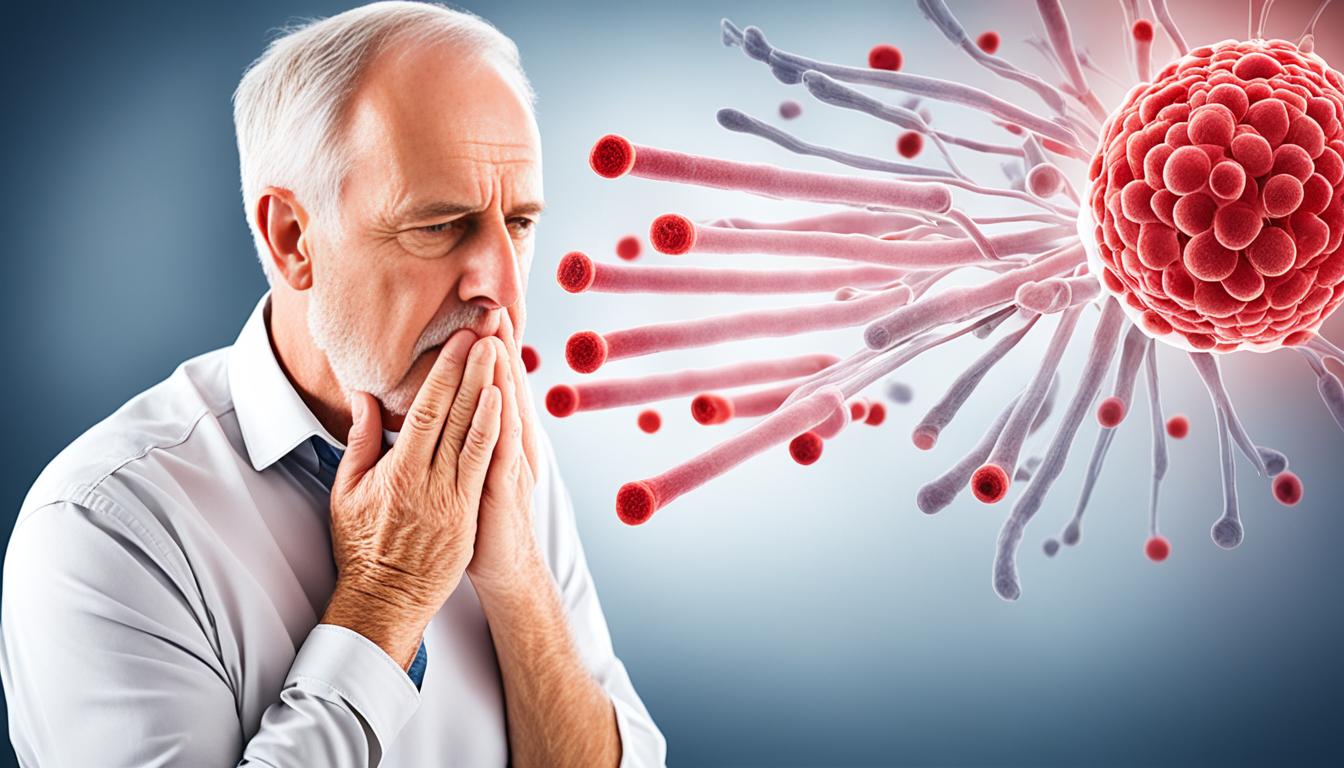Eosinophilic Granulomatosis with Polyangiitis (EGPA) is a rare condition. It causes blood vessel inflammation. This problem mostly affects the lungs and kidneys. But it can also involve other body parts. People with EGPA might experience a runny nose, sinus pain, and nose ulcers. Other common signs are coughing up blood, kidney issues, joint pain, and skin sores. The exact cause of EGPA remains unknown. However, experts think both genes and the environment play a part.
Doctors diagnose EGPA by looking at symptoms, running tests, and using imaging. Treatment focuses on using certain drugs like corticosteroids and immunosuppressants. In hard-to-treat cases, stem cell therapy might be an option.
Key Takeaways:
- Eosinophilic Granulomatosis with Polyangiitis (EGPA) is a rare autoimmune disorder characterized by inflammation of the blood vessels.
- Symptoms of EGPA can vary widely but commonly include respiratory tract and kidney manifestations, such as nasal ulcers, sinus pain, coughing up blood, kidney abnormalities, joint pain, and skin lesions.
- EGPA is believed to have a combination of genetic and environmental factors as causes.
- Diagnosis of EGPA involves clinical manifestations, laboratory tests, and imaging studies.
- Treatment for EGPA may include medications like corticosteroids, immunosuppressants, and biological agents.
- In severe and refractory cases, stem cell therapy may be considered as a potential treatment option.
Symptoms of Eosinophilic Granulomatosis with Polyangiitis
Eosinophilic Granulomatosis with Polyangiitis (EGPA) is a tricky autoimmune illness. It shows up with many different symptoms in various body parts. Knowing these signs helps find and treat the disease early.
This illness often affects breathing. It might cause:
- Persistent runny nose
- Nasal crusting
- Nasal obstruction
- Sinus pain
- Ulcers in the nasal lining
EGPA can also harm the kidneys. This can lead to issues such as:
- High blood pressure
- Fluid retention
- Changes in urine output
People with EGPA might feel joint pain, their muscles may swell, and they might have skin problems. These issues can make their days hard.
Other, less clear symptoms could show up in those with EGPA. These may include things like:
- Coughing up blood
- Inflammation of the lungs
- Chest pain
- Fatigue
- Weight loss
- Eye abnormalities
It’s key to know that EGPA’s symptoms differ for everyone. Diagnoses and treatments must match each person’s specific situation. This needs a careful check by the doctors.
Causes and Diagnosis of Eosinophilic Granulomatosis with Polyangiitis
Eosinophilic Granulomatosis with Polyangiitis (EGPA), or Churg-Strauss syndrome, is an autoimmune disorder. The immune system attacks the body’s tissues by mistake, causing inflammation and damage. It mainly harms the lungs and kidneys but can affect other areas as well.
This disease starts when certain white blood cells, known as neutrophils, kick into high gear. They make abnormal immune proteins, which form granulomas and harm blood vessels.
Most EGPA patients have specific antibodies in their blood, called antineutrophil cytoplasmic antibodies (ANCA). These ANCA can appear as cytoplasmic-ANCA (c-ANCA) or perinuclear-ANCA (p-ANCA). Finding these antibodies helps confirm the EGPA diagnosis.
The exact EGPA cause is still a mystery. Experts think it’s a mix of genetics and the environment. Some genes might make someone more likely to get EGPA, but the exact genes are not known.
Coming into contact with certain allergens or infections might kickstart EGPA in those who are genetically vulnerable. But, we need more studies to clarify these environmental triggers.
Doctors use various tests to diagnose EGPA. These include analyzing blood, where they might find high eosinophil levels and specific antibodies like ANCA. This helps them confirm the disease.
Imaging tests like X-rays and CT scans show if organs are affected. Sometimes, a tissue biopsy is needed to be sure about the diagnosis.
Stem Cell Therapy for Eosinophilic Granulomatosis with Polyangiitis
Stem cell therapy shows hope for those with severe EGPA, an autoimmune disease. It impacts the blood vessels. This unique method uses stem cells that can become different blood cells.
The process starts by collecting the patient’s stem cells. Then, high-dose chemotherapy is used to get rid of the faulty immune cells causing the condition. Afterward, the stored stem cells are given back to the patient. This allows a new and healthy immune system to grow.
This treatment aims to reset the immune system. It can help those who didn’t improve with regular treatments. Or those who faced hard times due to medicines that suppress the immune system. But, more studies are needed to know if stem cell therapy is safe and works well for EGPA.

